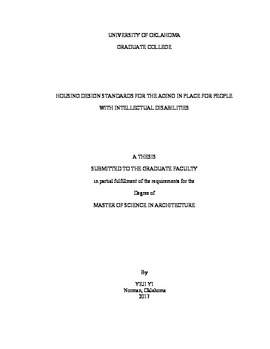| dc.description.abstract | Providing an appropriate domestic environment for elderly people with intellectual disabilities can be meaningful toward improving their independence and increasing their opportunities to age in place. Literature has documented that one's lifestyle and preference are impacted by one's domestic environment. Conceptually, this study seeks to contribute toward the knowledge body about the unique needs of people with intellectual disabilities and what factors contribute to increasing independence of people with intellectual disabilities and their satisfaction to ones' homes. Practically, the study purposes to provide design standards that not only secure users' safety and convenience but also their psychological well-being. With these standards in place, those with unique challenges might be suited to live their later life in a homelike environment that maximizes their dignity, privacy, independence, and autonomy. The study’s sample involves 51 participants with intellectual disabilities residing in South Korea. Two correlations are analyzed: correlations between living environments and independence of people with intellectual disabilities and correlations between living environments and their desire of aging in place. Caregivers who know the participants well completed measures of participants' living environment, independence, and desire to age in place. The correlational study identified 20 domestic environmental factors that need to be prioritized when designing housing for people with intellectual disabilities. Two domestic environmental factors were found to have positive correlations with both independence and desire to age in place: layout of the kitchen and lights of indoor space. Three significant and positive correlations were found between domestic environment and independence of people with intellectual disabilities: storage spaces, clear width and maneuvering clearance of entrance; and ranges in the kitchen. 15 domestic environmental factors are positively correlated with desire to age in place: ramps of accessible route, general attribute of the entrance, appliances of the kitchen, bathtubs, layouts, and heating systems in the bathroom, beds, closets, and general attributes of the bedroom, doors, electric equipment, windows, floors, walls, and furniture in indoor common area. The study’s results are meaningful as they contribute to not only academic knowledge pertaining the relationship between environmental attributes and human behaviors, but also for the practical advantages in developing pleasant domestic environment for people with intellectual disabilities.
Keywords: housing design guideline, aging in place, independent life, people with intellectual disabilities, domestic environment | en_US |
